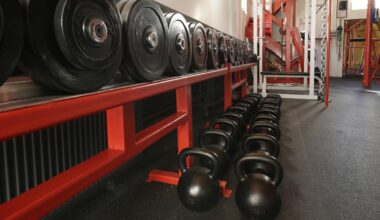Guided Breathing and Relaxation Exercises for Pregnancy Back Pain
Pregnancy brings many changes to the body, with back pain being a common concern. Expecting mothers can benefit greatly from guided breathing and relaxation exercises, which promote physical and mental well-being. These exercises strengthen core muscles, support improved posture, and allow for greater flexibility. Incorporating gradual changes into daily routines can significantly enhance ease and comfort. Employing techniques like deep belly breathing not only helps alleviate tension but also fosters relaxation while relieving discomfort. As you focus on your breath, it’s essential to cozy up in a supportive position, possibly using pillows or cushions. Each session should start by centering your mind and setting intentions for relaxation and pain management. Additionally, these exercises can be beneficial both during pregnancy and post-delivery, laying a foundation for continued fitness and recovery. Combining relaxation with gentle physical activity aids in reducing anxiety and stress levels. As you progress, listen to your body’s signals. It’s important to take regular breaks from sustained activities and to focus on breathing fully and deeply throughout the day.
Understanding Back Pain in Pregnancy
Back pain during pregnancy is often attributed to hormonal changes, weight gain, and an altered center of gravity. As the baby grows, the body undergoes significant changes that can lead to discomfort. Maintaining a strong back and abdominal core is crucial for expecting mothers, helping to redistribute weight and balance. Incorporating specific exercises can help pregnant individuals build strength, enhance flexibility, and reduce back pain. Simple stretches can release muscle tension while enhancing blood flow to the affected areas. As muscle pain can disrupt sleep patterns, effective relaxation techniques are beneficial targets for alleviating discomfort at night. Integrating this understanding can motivate a consistent exercise routine tailored to managing back pain. Practicing relaxation techniques like guided imagery or progressive muscle relaxation may also support emotional well-being while coping with physical discomfort. Keeping in touch with healthcare providers can ensure that exercise routines remain safe and comfortable. Additionally, exploring other methods such as hot/cold therapy, acupuncture, or prenatal massage therapy can complement an exercise routine while addressing chronic back pain during pregnancy.
Creating a dedicated space for relaxation at home can enhance the effectiveness of these exercises. Designate an area that feels peaceful and serene, where you can focus solely on your well-being. Use cushions, low lighting, and soft music to create a calming atmosphere conducive to relaxation. Begin your sessions with a few minutes of deep breathing, inhaling through the nose and exhaling slowly through the mouth. As you breathe, visualize relaxing each part of your body, starting from the head and moving down to the feet. Gradually, this visualization aids in releasing tension stored in various areas, including the back. With each breath, aim to deepen your inhalations and extend exhalations, further encouraging relaxation. It’s also beneficial to integrate stretches that promote ease within your back and hips. Focus on gentle movements, being aware not to overextend yourself. Enhancing flexibility will ultimately assist in pain management and improve overall comfort levels. These simple yet effective strategies will enable mothers-to-be to feel connected to their bodies, making the journey of pregnancy more enjoyable and manageable.
Breathing Techniques for Relief
Effective breathing techniques may offer immediate relief from back pain experienced during pregnancy. One popular method is diaphragmatic breathing, which engages the diaphragm and fosters deep, full breaths. To practice this technique, find a comfortable position, whether sitting or lying down, and place one hand on your belly and another on your chest. As you inhale deeply through your nose, feel your belly expand, ensuring your chest remains relatively still. Hold the breath for a few seconds, then exhale slowly through your mouth. Repeat this process for several minutes, allowing yourself to center your focus on each breath. This method can also alleviate anxiety, facilitating increased relaxation of both body and mind. Additionally, you can integrate breathing exercises during gentle stretches, enhancing the benefits of both practices. For instance, while reaching to touch your toes, focus on your breath to maintain relaxation. Breathing techniques like these are highly accessible and can be performed at any time during the day. They allow for greater self-connection as you calmly navigate the changes occurring within your body.
Integrating guided visualization during breathing exercises can amplify their effects. Visualization techniques involve picturing calming scenes or scenarios while engaging in deep breathing. These could be serene landscapes, such as a tranquil beach or a peaceful forest. Choosing a preferred setting can encourage relaxation and help redirect focus away from discomfort. By pairing your visualizations with slow breathing patterns, the body may begin to release pent-up tension, creating a soothing effect on both the mind and body. You might consider seeking out guided audio sessions that specialize in mindfulness or prenatal care to complement your practice. Sessions can provide prompts that enhance the overall experience, making it easier to let go of intrusive thoughts. Strive to spend at least a few minutes each day practicing these techniques as regular engagement can yield noticeable benefits. Over time, as you grow more familiar with the practice of visualization, you may find it easier to settle into these moments of calmness. Practicing this at various points throughout the day can create lasting improvements, ultimately promoting better well-being.
Combining Movement with Relaxation
It’s essential not only to focus on breathing but also to include gentle movement with relaxation practices. Simple movements like pelvic tilts can ease back pain, enhancing flexibility in your back. To perform a pelvic tilt, simply get into a comfortable position on your hands and knees, ensuring your back is flat. Gently push your pelvis upward while arching your back. Hold for a few moments before returning to a neutral position. This stretch can provide significant relief, especially when combined with deep breathing. Incorporating movements into your routine may help maintain a balance between strength and flexibility, addressing the ongoing discomfort. Attending prenatal yoga classes can further provide encouragement to learn essential postures that support muscle engagement. Many expectant mothers find these classes to be a wonderful space for connection and support. Being guided through gentle poses while focusing on breathwork can empower your journey throughout pregnancy. This combination enhances a sense of safety and connection with your changing body. Always communicate with your instructor regarding your comfort levels, allowing for necessary modifications to be integrated smoothly.
As mothers-to-be progress through each stage of pregnancy, understanding how to adapt movements becomes vital. Staying mindful of your body’s signals ensures a unique balance between activity and rest, catering properly to individual needs. Maintaining an open dialogue with healthcare providers can aid in personalizing your exercise routine, ensuring it aligns with your physical capacity. These adaptations may include reducing the intensity or frequency of exercises as necessary. Surrounding yourself with support from friends or family who encourage your journey can significantly enhance the experience. Furthermore, tracking your exercise routine can provide motivation and support accountability. Keeping a journal or using smartphone applications can allow you to log daily practices while noting the benefits you observe. Recognizing progress encourages continued engagement, while introducing gentle challenges may help maintain enthusiasm. Lastly, seeking out group classes tailored to pregnancy can foster connection while assisting in maintaining motivation within a community. Embracing flexibility while remaining consistent in these practices will promote lasting well-being as you navigate both pregnancy and the transition into motherhood.





